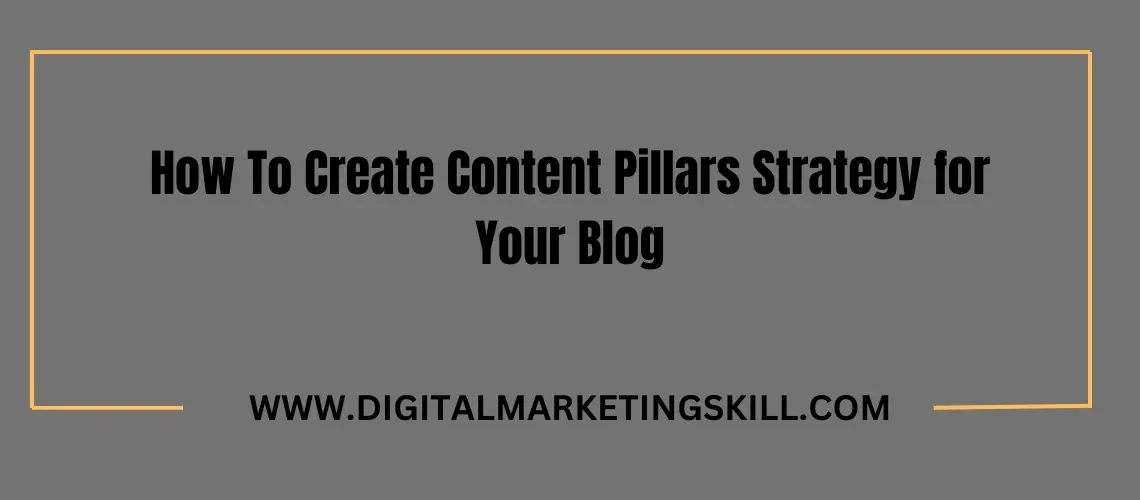One of the biggest challenges for many marketers is creating content that is clear, engaging and connects with their audience. Without a clear plan, even the best content can miss the mark, making it hard for your brand to stand out.
This is where “content pillars” come into play, it is a strategic approach that organizes all of your content around central themes or topics, providing comprehensive information and guiding readers through related subtopics smoothly.
When you can organize your content around these pillars, you can simplify your creation process while improving both SEO performance and user experience.
If you’re looking to learn this approach, Digital Marketing Skill Institute (DMSI) offers a comprehensive digital marketing course that can guide you to effectively develop and utilize content pillars for your brand’s success.
So let’s get started
What Are Content Pillars?
Content pillars are broad themes or topics that serve as the foundation for all your content creation efforts. They are the main categories under which all your content can be organized. This topic can be posted on your website, social media and any other relevant platforms to drive traffic.
Examples of content pillars include such as blog posts, videos, infographics, and social media post, these content types can be broken down into smaller, related topics, allowing you to create a variety of around a central theme.
If your content pillar is about “Digital Marketing” you could create an in-depth guide that covers various subtopics like SEO, email marketing, and social media. Each of these subtopics can then be developed into individual blog posts or videos that link back to the main pillar page.
Get 50% Discount to Master ALL Aspects of Digital Marketing That Can Earn You $2,500 - $5,000 a month (Even if you are a complete beginner!)
Our students that intentionally implement what they learn from our digital marketing course make back the entire course fee within a single month or more after completing our course because our course gives them many income generating options with unlimited earning potential with no age or location barrier. The best part is no technical skills are required.
An opportunity to change your lifestyle and make money working from anywhere in the world. The results our students get from our digital marketing course prove this could be applied to any market or country and that it is designed for any skill level and work background.
*By signing up, you agree to our privacy policy and terms of service.
This approach improves your search engine optimization (SEO) through strong internal linking and provides your audience with a comprehensive resource on the subject.
When you use content pillars, you can streamline your content creation process, maintain consistency in your messaging, and effectively engage your audience across multiple channels.
Why Are Content Pillars Important?
Content pillars are crucial for any solid content marketing plan. They act as the main framework for your content creation efforts, helping you organize all of your content and posts around specific themes.
Increased Website Traffic
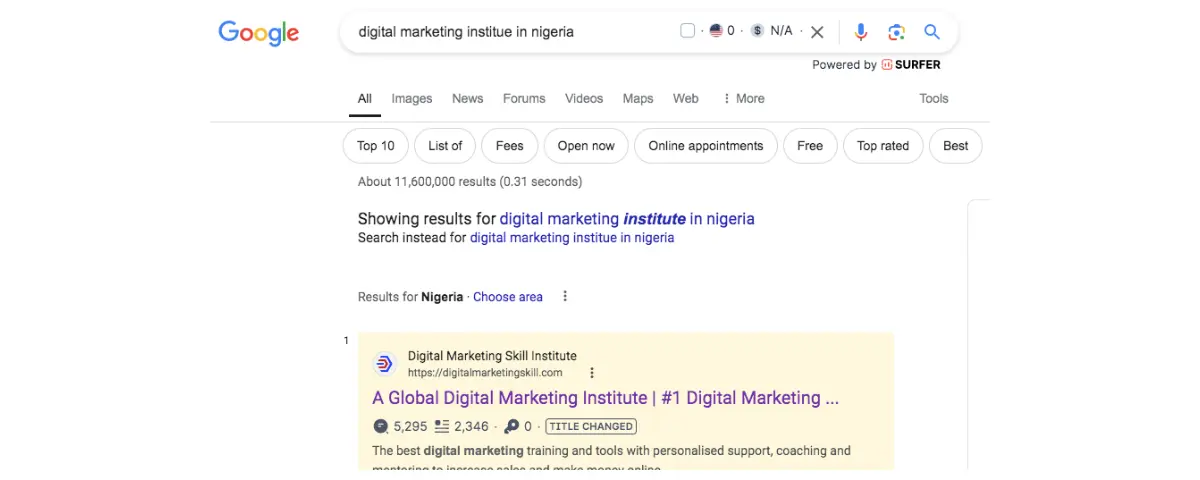
Content pillars help attract more visitors to your website by providing comprehensive and relevant information on specific topics. When you create high-quality content around these pillars, search engines are more likely to rank your pages higher, leading to increased visibility and traffic.
Structured Organization
Content pillars can help you categorize related topics under specific themes to make it easier for both your audience and search engines to navigate your site. This structured approach enhances user experience and keeps your messaging consistent.
Content Opportunities
With defined pillars, you can easily generate a variety of related content pieces, such as blog posts, videos, infographics, and social media updates. This versatility allows for a more dynamic content strategy that can reach audiences across different platforms.
Authority Building
When you consistently produce high-quality content around specific pillars, you can establish your brand as an authority in those areas. This helps build trust with your audience and positions you as a go-to source for information relating to your field.
Efficient Resource Allocation
Content pillars enable efficient resource allocation by allowing you to focus your time and efforts on specific themes. This targeted approach helps streamline content creation, ensuring that your team can produce quality materials without spreading resources too thin across unrelated topics.
Content Pillars vs. Topic Clusters – What’s the Difference?
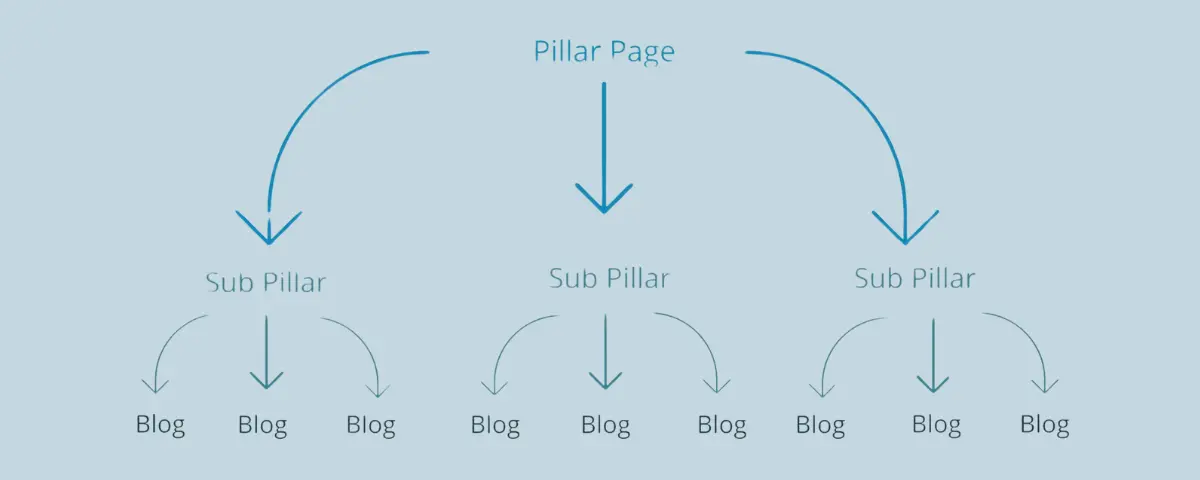
These are two important strategies in content marketing, but they serve different purposes and structures.
Content Pillars are comprehensive pieces of content that cover a broad topic in-depth. They act as standalone resources, providing valuable information and insights on a specific subject. The goal of a content pillar is to establish authority on that topic and serve as a central resource for readers.
Topic Clusters, on the other hand, are a structured approach to organizing related content around a central theme. This strategy involves creating a “hub” page (the pillar) that links to multiple “cluster” pages, which delve into specific subtopics related to the main theme.
For instance, if the hub page is about “Digital Marketing Strategies” the cluster pages could cover topics like “SEO Best Practices,” “Effective Email Campaigns,” and “Social Media Advertising.” Each cluster page links back to the hub page, creating an interconnected web of content that improves navigation and SEO.
Finally, while content pillars focus on delivering comprehensive information on a broad topic, topic clusters organize related content into a cohesive structure that improves user experience and search engine rankings.
Types of Content Pillars
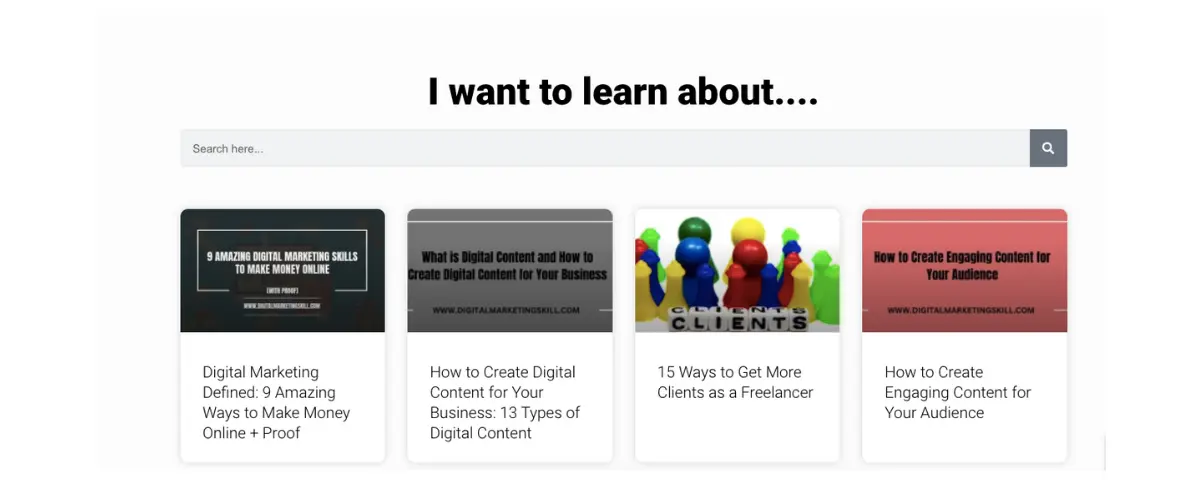
Content pillars serve as the foundation for your content strategy, guiding the topics and themes you focus on. Some of the common types of content pillars:
- The Guide
- The What-Is
- The How-To
1. Guide
A “guide” is a comprehensive resource that provides step-by-step instructions or detailed information on a specific topic. It helps readers understand complex subjects by breaking them down into manageable parts.
For example, a guide on “How to Start a Blog” might cover everything from choosing a platform to promoting content. These guides are valuable for establishing authority and attracting traffic, as they offer practical advice that readers can easily follow.
2. What is
The “What Is” content pillar explains a specific concept or term clearly and straightforwardly. This type of content helps readers understand the basics of a subject, such as “What Is SEO?” or “What Is Content Marketing?
When you provide foundational knowledge, these pieces serve as valuable resources for beginners and can attract traffic from those seeking to learn more about a particular topic.
3. How To
The “How To” content pillar provides practical, step-by-step instructions on completing specific tasks or achieving particular goals. This type of content is highly valuable because it directly addresses the needs of your audience, offering actionable insights.
For example, a “How To” article might cover topics like “How to Create an Effective Marketing Plan” or “How to Optimize Your Website for SEO.” When you deliver clear guidance, these pieces can help you engage your readers and also position your brand as a helpful resource.
How to develop a content pillar strategy for your blog
Creating content pillars is about organizing important topics that will shape your content strategy. Below is a simple step-by-step guide to help you set up effective content pillars:
Do Your Audience Research
Conducting thorough audience research is the first step in developing an effective content pillar strategy.
Start by identifying your buyer personas, “who they are, what they care about, and the challenges they face“. You can gather this information through surveys, interviews, or social media polls.
If you are not sure of who your target audience is? Start by creating a buyer persona. This will help you have an idea of your target needs, interests, and pain points to understand what information would be most valuable to them.
Additionally, you can analyze your existing blog traffic to see which topics resonate most with your readers and social media interactions. This insight will help you choose relevant topics that align with your audience’s interests.
When you understand who you want to target, you can create content pillars that attract readers and provide valuable solutions, ultimately improving your engagement and building loyalty.
Select Broad Topics
To select the best topic for your brand, you need to start by brainstorming themes related to your niche that resonate deeply with your audience.
These topics should be broad enough to encompass multiple subtopics but specific enough to be meaningful.
For instance, if you’re running a tech blog, your broad topics might include “Smart Home Devices,” “Cybersecurity,” or “Emerging Technologies.” These themes can then be broken down into more specific articles like “Top Smart Home Devices” or “Basic Cybersecurity Tips.”
When you choose topics that align closely with your brand, it helps you provide value to your target audience and position you as an expert in the field. Also, ensure these themes are substantial enough to attract readers who are genuinely interested in learning more.
Conduct Keyword Research
To develop a pillar page, you need to research to understand what your audience is searching for online. Start by using keyword research tools like Google Keyword Planner, Ubersuggest, or SEMrush to find relevant keywords related to your broad topics.
You can input your broad topic or keyword relating to your niche into the keyword tools to see which one has a good search volume and manageable competition.
Also, you can focus on long-tail keywords, as they are more specific and often indicate a clearer intent from the searcher. For example, instead of just “fitness,” you might find “beginner home workout routines.”
Once you have a list of keywords, use them to guide your content creation. You should incorporate these keywords naturally into your pillar pages and supporting articles. This will improve your chances of ranking higher in search engines, making it easier for your audience to find your valuable content.
Define Subtopics
After establishing your main content pillars, it’s important to identify the subtopics that will support each pillar. For example, if your pillar is “Content Marketing Strategies,” you might brainstorm subtopics like “How to Create a Content Calendar,” “The Importance of SEO in Content Marketing,” and “Measuring Content Marketing ROI.”
These subtopics should link back to the main pillar page, creating a cohesive structure that enhances user experience and SEO. When you address these specific questions or themes, you provide valuable insights that keep your audience engaged.
This interconnected approach will help readers find related content easily and strengthen your authority in the marketing space, making it clear that you have comprehensive knowledge on the subject.
Create Content Pillar
These pages should provide comprehensive information on your main topics, serving as the central hub for related content. Start by writing an in-depth article that covers all aspects of the pillar topic, ensuring it is well-organized and easy to read.
When creating the content, ensure you use clear formality such as subheadings, bullet points, and visuals to improve readability. Make sure to incorporate relevant keywords naturally to improve SEO.
This will help the reader navigate the page easily and also signal to search engines that your content is interconnected.
By developing strong content pillar pages, you establish authority on the subject and create a valuable resource for your audience, encouraging them to explore more of your blog.
Link Related Content
Once you have your pillar pages and supporting articles, interlink them effectively.
You can start by including links from your subtopic articles back to the main pillar page. This helps readers easily navigate to broader information and encourages them to explore more of your content.
Additionally, links between subtopics were relevant. For example, if you have a pillar on “Social Media Marketing,” and a subtopic on “Instagram Strategies,” you can link to another subtopic about “Creating Engaging Visual Content.”
This interconnected approach will help enhance user experience and also improve SEO by signalling to search engines that your content is related and valuable.
When you guide readers through your content seamlessly, you keep them engaged longer and increase the chances of conversions.
Monitor Performance
After publishing, you need to track the performance of your content pillars using analytics tools. One of the analytics tools you can use is Google Analytics. This tool can you track key metrics such as page views, bounce rates, and average time spent on each page.
So you need to pay attention to which pillar pages and subtopics attract the most traffic and engagement. Additionally, assess how well your content ranks in search engines for targeted keywords.
This will help you understand what resonates with your audience and where improvements are needed. When you review this data regularly, it allows you to refine your content strategy over time, or adjust your SEO tactics.
Example of a Great Content Pillars
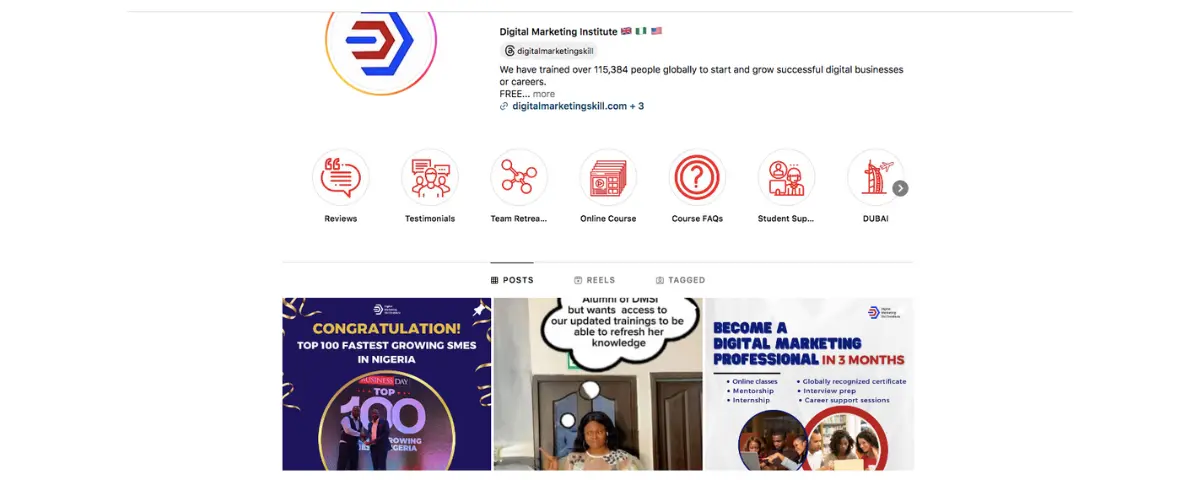
Digital Marketing Skill Institute
Content Pillars: Digital Marketing, Search Engine Optimization, Content Marketing, and Social Media
The Institute uses its content pillars pages to guide and amplify its messaging across various channels. The brand covers a wide range of topics, from content marketing, Search Engine Optimization, and online advertising strategies to analytics, making it a go-to resource for businesses looking to improve their digital presence through marketing.
Additionally, they provide valuable insights into best practices for improving website visibility, creating engaging and valuable content, and guiding readers on how to connect with their audience effectively. Finally, you can learn proven strategies to leverage different platforms like Facebook and Instagram to build brand loyalty.
When you maintain a consistent message across these pillars, it can effectively engage its audience and drive traffic to its website, reinforcing its position as a leader in digital marketing education.
The Bottomline
Content pillars are a vital part of any successful content strategy. They provide a clear framework that helps you organize your ideas and maintain consistency across all your content. When you focus on a few key themes, you can create valuable and engaging material that resonates with your audience.
Also, using the right content pillars can guide your content creation process and also strengthen your brand’s authority and trustworthiness. As you develop your strategy, take the time to identify topics that align with your audience’s interests and your brand values.
At DMSI, we believe in the power of content pillars to strengthen your brand’s online presence. If you want to learn how to create effective content pillar posts for your brand, now is the perfect time to take action. Our digital marketing course are designed to guide you through the process step-by-step, helping you identify key themes that resonate with your audience.
When you learn how to use content pillars effectively, it can lead to improved engagement, better SEO performance, and a more cohesive online presence for your brand.
Content pillars FAQ
How Many Content Pillars Should You Have?
It’s generally recommended to have three to five content pillars for your strategy. This range allows you to cover a variety of topics without overwhelming your audience or diluting your message. Each pillar should represent a key theme that aligns with your brand and resonates with your target audience. When you focus on a manageable number of pillars, you can ensure that your content remains consistent and relevant across different platforms.
What Are Content Pillars in Social Media?
Content pillars in social media are key themes or broad topics that guide your content creation efforts. They help keep your posts focused and ensure consistency in messaging. When you establish these pillars, you can build authority around specific subjects, making it easier for your audience to recognize and engage with your brand.
Are Content Pillars Still Relevant?
Yes, content pillars are still very relevant today. They provide a structured approach to content creation, helping brands maintain consistency and coherence in their messaging. When you have a pillar page, it allows you to adapt while staying true to your core themes. This relevance is crucial for building trust and authority with your audience, ensuring that they see your brand as a reliable source of information.
How Do You Identify Your Content Pillars?
To identify your content pillars, start by understanding your target audience and their interests. Conduct research to find out what topics resonate with them and what pain points they have. Once you have this information, brainstorm broad themes that align with both your audience’s needs and your brand values. Aim for three to five key areas that will serve as the foundation for all your content. You can also use keyword research tools to discover popular topics related to your niche.This will help you decide the best topic for your pillar page.
More Resources
Digital Marketing Defined: 9 Amazing Ways to Make Money Online + Proof
How to Create Digital Content for Your Business: 13 Types of Digital Content
How to Create Engaging Content for Your Audience
9 Steps to Create a Digital Marketing Plan for Your Business

